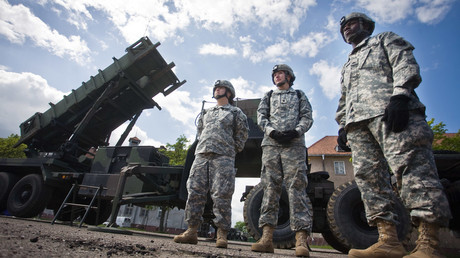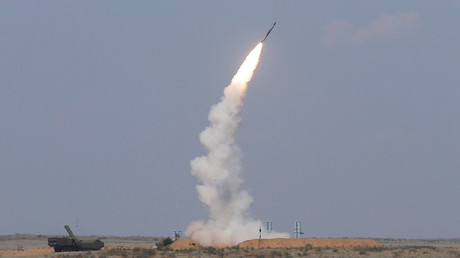
US WOULD FACE NO 'THREATS' IF IT KEPT ITS TROOPS & WAR MACHINES INSIDE ITS OWN BORERS
Finian Cunningham

John Bolton, the national-security adviser to President Trump, was in Moscow this week meeting Russian leader Vladimir Putin and other senior Kremlin officials. Bolton huffed that the Intermediate-range Nuclear Forces (INF) Treaty was obsolete from the US point of view.
“There’s a new strategic reality out there,” said the American official. The INF, signed in 1987, is “a bilateral treaty in a multipolar ballistic missile world.”
He was referring to countries like China, Iran and North Korea, which the US claims have built up arsenals of ballistic missiles prohibited by the INF. Those countries are not in violation of the said treaty because the INF was an agreement signed only by the US and the Soviet Union, later becoming the Russian Federation.
The INF banned ground-launched ballistic and cruise missiles with a range of between 500km and 5,500km.
By quitting the treaty, the US would, in theory, be free to deploy medium-range nuclear and non-nuclear ballistic missiles on the territories of European NATO members. That is, return to the situation of the early 1980s before the INF was agreed by then-president Ronald Reagan and Soviet leader Mikhail Gorbachev. The US would also be free to make similar deployments in its Pacific bases and allied countries, such as Japan and South Korea.
However, it is doubtful if Washington would be able to do this without causing major political problems with its allies. This week, European leaders strongly protested against the US plan to withdraw from the INF. Even the usually obliging Norwegian head of NATO, Jens Stoltenberg, said European countries would not welcome the return of American nuclear missiles on their soil.
Washington for several years now has been accusing Russia of violating the INF, for allegedly developing a ground-based cruise missile. Moscow has repeatedly denied the claim, pointing out that the US has not presented any evidence to support its accusation.
For its part, Moscow says the US is the party that is in violation of the treaty from its installation of Aegis Ashore missile systems in Romania and Poland.
What could be the real cause of American concern is Russia’s new Kalibr cruise missiles that are launched from navy ships. The missile was used with devastating success against militant groups in Syria, launched from the Caspian Sea, and covering a distance of over 1,000km. Sea-launched missiles are not banned by the INF.
In any case, the missiles pertinent to the INF, whether belonging to Russia, China or some other nation, are only a threat to US forces because American military power is increasingly deployed closer to those countries.
The US military has troops in an estimated 150 countries around the world. That’s a global military footprint covering nearly 80 percent of all nations on the planet. Given that inordinate spread of US military, it is easy to see why American officials perceive “threats.” It’s a bit like a thief marauding outside homes and then complaining that the homeowners are installing “threatening” burglar protection systems.
By contrast, Russian and Chinese military forces are predominantly confined to their respective national territories. Last month, when Russia conducted its Vostok-2018 war maneuvers in Siberia and the Far East, they were described as the largest-ever military mobilization by Moscow since the end of the Cold War. But let’s not forget, Russia’s war drills are always held within its territory.
This week, the US-led NATO alliance is conducting its biggest-ever war drills since the Cold War in the North Atlantic, Scandinavia and Baltic Sea. More than 30 nations are participating with a total of 50,000 troops and hundreds of aircraft and warships. The Trident Juncture mobilization will be held for the next four weeks and comes within 500km of Russian territory.
The anomalous imbalance should be glaringly obvious. Russia conducts its war drills within its own borders, which is its sovereign right; while American and allied forces are conducting simulated offensive actions on Russia’s doorstep.
The same double-think applies to the Trump administration’s complaint that Russia and others are in breach of the INF. If American forces were not encroaching on the territory of Russia and China, then they wouldn’t have cause for perceiving threats.
The distance between Beijing and San Francisco on the US west coast is nearly 10,000km. At its closest, the American state of Alaska is about 6,000km from Beijing. Those ranges are beyond the 5,500km upper limit of the INF. The point is that INF-type missiles from China or North Korea do not threaten US mainland territory. The only reason why US interests are “threatened” is because American forces are deployed in the vicinity of these countries, such as in the South China Sea, or in South Korea and Japan.
The next category of missile up is the Inter-Continental Ballistic Missiles (ICMBs). They are covered by the New START treaty. American officials, including John Bolton, are showing a tepid regard about renewing START when it expires in 2021. Many observers, including Americans, are concerned that with the scrapping of the INF by the US, then the last remaining arms-control treaty will also be abandoned. That then could unleash a new global arms race and greatly increase the risk of a nuclear war.
Lamentably, the US is tearing up the INF, as it did previously with the Anti-Ballistic Missile (ABM) Treaty in 2002, based on irrational arguments.
US military forces are only “threatened” because its forces are in everyone’s face in far-flung corners of the planet. Short- and medium-range “threats” would not be threats if America kept its troops and war machines within its own borders.
Donald Trump was elected partly on the promise to scale back US overseas militarism. It has turned out to be an empty and futile promise. That’s because American militarism is a vital, incorrigible function of its ambitions for domination of the planet. Ripping up arms-controls treaties is the corollary of such a monstrous military machine. Ironically, the treaties are trashed because the poor little American monster says it is being “threatened.”
Like this story? Share it with a friend!
The statements, views and opinions expressed in this column are solely those of the author and do not necessarily represent those of RT.



